Guitar Review: Sparrow Primitive Boss
Looking through the guitar auctions on eBay recently, I was astounded by the number of cheap guitars on offer. Most of these are copies of the most popular models out there, made as cheaply as possible (and some in the most garish of colours!), made mostly in China and at sold at prices too good to believe. I have never had the courage to buy one of these, being of the firm belief that you get what you pay for. However, I have always wanted to buy a Strat replica on the cheap, rip the thing apart, overhaul, upgrade and hot-rod everything and – hey presto – I’ll have a respectable workhorse guitar at a cheap price!
Well, that is pretty much what the folks at the Sparrow Guitar Co. do, albeit on a larger and more skilful scale. The brainchild of Billy Bones (yep, that’s his real name!), they manufacture ‘bare-bone’ guitars in their factories in Asia. The quality control there is handled by Scott Zimmerman, an ex-Fender master builder. The guitars are then shipped to their shop in Vancouver, Canada, where they are basically taken apart, overhauled, upgraded and re-assembled before being subjected to further quality checks by master luthiers.
As a result, Sparrow guitars are very well-made and can come equipped with a variety of upmarket hardware like Bigsby tremolos, Kent Armstrong, Bill Lawrence or TV Jones pickups and Grover tuners. The result is a pro-level guitar of high quality that is significantly cheaper than those of the big-name brands.
But that’s not all. Sparrow’s main draw card is the option to customise the paintwork of your guitar. You can choose from selected base colours and hand-painted designs like pinstripes, webbing and flames, to name a few, for a nominal fee.
Sparrow currently offers models based on several current favourites: The Big Daddy (Gretsch-like hollow body), The Primitive (semi-hollow body), The Rat Rod (Les Paul shape) and the Twangmaster (Telecaster shape). Also within each model, there are 3 price points: Pro (basic pro-level), Boss (with Kent Armstrong pickups and Grover tuners) and Ace (same as the Boss with a Bigsby tremolo).
Firstly, many thanks to the kind folks at Niche Music Supplies (www.nichemusicsupplies.com) who are the Australian distributors for Sparrow Guitars. They have kindly agreed to loan us the Primitive Boss model for our review, so without further ado…
The Specs
The Primitive is Sparrow’s semi-hollow bodied guitar (similar to an Epiphone Dot). It comes equipped with Kent Armstrong alnico humbuckers, and a standard complement of a 3-way toggle switch, 2 volume and 2 tone knobs. The tuning machines are the industry-standard Grovers and they performed as expected and the guitar also came equipped with stainless steel frets and a bone nut. I was also pleased to note that the shielding of the electronics cavity is standard procedure for Sparrow guitars. Fretwork is extremely tidy and the factory setup is second to none. More on this later. The Primitive came strung with Rockers 10’s.
The hand-painted hot-rod flame artwork looked simply delicious and almost 3-dimenional. Everyone I showed the guitar to responded with a wide-eyed “Wow!” If you want a guitar that will make you stand out from the crowd, this is it. According to Sparrow’s website, they hand-paint the custom designs over the base coat before applying the final lacquered finish so the artwork stays well protected. The finish was so glossy and highly polished that I found it a challenge to photograph the guitar without any unfavourable reflections appearing on the mirror-like finish! My only gripe (and it’s a small one) was that the first-rate bodywork made the plastic Sparrow logo on the headstock and truss rod cover look cheap by comparison.
[edit: we’ve been notified that the logo and truss rod cover are actually made from cast metal. Thanks to Jordan Eshpeter from Sparrow Guitars, and Michael K. from the comments, for pointing this out. -ed]
Unplugged
The first thing that struck me as I bent down to take the guitar out of its hard case was its weight. Let me qualify this – if you’re used to playing weighty solid-bodies like Les Pauls or Explorers, this will not be an issue for you. I’ve also found that these heavy guitars usually benefit from plenty of sustain and this is certainly the case with the Primitive.
The one thing I always do when trying out a guitar for the first time is to play it unplugged. More often than not, if it sounds good unplugged, it will sound great plugged in. The Primitive exhibits a bright character due to its maple construction. There was also a hint of wood due to the semi-hollow body and rosewood fret board. My initial impression was that this would be a great guitar to plug straight into a cranked amp and start banging out those open chords.
The quality of the setup is extremely impressive. This really shone through during my initial play through. Intonation was simply perfect up and down the neck and as hard as I tried, I could not find a single dead spot, or fret buzz anywhere. I have played several guitars costing twice as much as the Sparrow Primitive, and all of them required some work to get them properly set up out of the box. Straight from the case (after a quick tune-up), the Primitive played like a dream which speaks well of the rigorous QA that Sparrow puts their guitars through.
The neck profile seemed closer to a D-shape which offered my hand plenty to grip on. I prefer my guitar strapped on at a comfortable medium height, but for those who like to have their guitars hanging down low to their knees, a comfortable meaty neck to grip on to is essential. Upper fret access is very generous and I had no problems playing right up to the end of the fret board, and let me mention again that the intonation and action was consistently good throughout.
Plugged in
For starters, I plugged the Primitive straight into my 15w Fender Blues Jr. set close to break-up, I was pleasantly surprised by the quality of the Kent Armstrong pickups particularly the bridge pickup. It wasn’t as hot as the Seymour Duncan SH-4 JB model in my Maton. I’m guessing these were the Kent Armstrong low-output alnico humbuckers, as they didn’t push my Blues Jr. into overdrive as easily as the SH-4. However, kicking in some sort of a boost, like an MXR Micro Drive (or similar pedal) yielded a strident tone that smacked of Malcolm Young. There was good definition in the top-end with subdued mids and a tight bottom end. Even heavily overdriven and strummed hard, things still stayed reasonably balanced. This is a very competent workhorse pickup with a versatile voicing.
The neck pickup brings some warmth to the party, and with it I was able to coax a good variety of sounds, from soulful blues licks to tight compressed Santana-esque leads and even some smooth jazz lines if you back off the tone knob enough. Strummed hard, this pickup will get muddy, so I suspect most people would favour the bridge pickup for rhythm work, but single-notes still have plenty of articulation and sustain.
With both pickups selected, you get a little more of the bridge pickup’s definition added to the warmth of the neck pickup, which I found quite agreeable when strummed clean. However, with some dirt applied and played in a full-band situation, there wasn’t a lot of difference between the neck pickup alone compared to the neck and bridge pickups together.
Played live
Now, the colour of a guitar has no bearing on its tone right? Wrong! There’s something to be said for the excitement and energy produced when you know you’re playing a guitar that just screams “Look at me!” You’re conscious that people now are looking at you and for me, which just spurs me on to play that little bit better.
My set included a lively bluesy number and several medium and slow-paced contemporary Christian tunes, backed by bass and drums played in a small, intimate setting. As expected, I favoured the definition of the bridge pickup during the faster songs and I switched to the neck pickups during the slower songs, where the warm lows complemented the arpeggios I was playing to fill in the musical space. The Primitive sat easily against the backdrop of bass and drums, never fighting for space, although with trios, instrumental competition isn’t usually an issue. Contrary to its looks, the Primitive surprised me with how well-behaved it was. I didn’t get the opportunity to run the amp wide open with a lot of drive during the live gig, but quick tests during rehearsals indicate that the Primitive could get downright nasty if it wanted to.
The guitar was heavier than what I was used to, but I’m not a big guy. However, the balance of the guitar was just right.
Conclusion
You can blame a lot of bad things on globalization, but for guitarists, the opening of the Asian economies has provided us with access to cheaper materials. Enterprising companies like Sparrow have taken advantage of this and coupled it with a top-notch quality control process and sheer artistic genius to create a pro-level guitar at an affordable price. I have been privileged to review this guitar and while I have yet to see a Sparrow guitar at my local music shop, after having experienced it for myself, I know it won’t be long before I see people walking out with a Sparrow Primitive adorned with hot-rod flames and a big smile on their faces.
For more information on the Sparrow Primitive Boss, or on Sparrow Guitars, visit their website at www.sparrowguitars.com.
Sound Bytes
Reviews are highly subjective. Player setups, playing environments and player technique all have a significant impact on what tone you will get out of your gear. Even the age of a player could have an impact as your hearing can change over the course of your life. As such, I try to list all aspects of the gear used in this review so you can judge for yourself how my setup might influence the reviewed item and how it might sound with your gear.
Equipment used for this review:
- Sparrow Primitive Boss, a semi-hollow electric guitar, maple body, rosewood fretboard, equipped with 2 Kent Armstrong alnico humbuckers (neck & bridge), Grover tuners, 2 volume, 2 tone and 3-way pickup selector. Strung with Rocker’s 10’s.
- Fender Blues Junior – Tweed Edition, a 15-watt all-tube amp equipped with a 12” Jensen C12N ceramic speaker. Tube complement includes 2 x 12AX7 Sovteks (preamp) and 2 x EL84 Groove Tubes (power amp). Controls were set as follows: Volume 5, Treble 6, Bass 6, Mid 6, Master 5, Reverb 0, Fat Switch off
- Matamp Minimat II, a 4-watt all-tube amp, connected to a 1 x 12 open-backed cabinet with a 12” Tone Tubby alnico speaker. Tube complement includes 2 x ECC83 (preamp) and 1 x 6V6 (power amp). Controls were set as follows: Gain 1 o’clock, Master Volume 3 o’clock, Tone set at max. The Minimat II also comes with an in-built boost (similar to an MXR Micro Amp) which was engaged, with the Boost knob at 1 o’clock.
- Signal chain:Guitar -> Gristle King Boost/Overdrive -> Fender, orGuitar -> Minimat II
- Recording setup: I used a Zoom H2 recorder set around 2 metres (approx 6.5 feet) in front of the amp. I opted for this method (versus the usual method of a Shure SM57 in front of the speaker) as I felt this conveyed a more realistic and uncoloured sound. The only post processing done was to normalise the .wav file before converting it to .mp3 format on Adobe Audition 3.
Sound files and Notes
Play: sparrow-primitive-arpeggio
A simple arpeggio, played clean through the Fender Blues Jr., repeated 3 times. Once with the bridge humbucker, once with both pickups and one more time with the neck humbucker. The bridge humbucker has a very present mid-range and the highs are sweet. With both pickups engaged, you lose some of the present mids in exchange for the warmth of the neck mixed in with those sweet highs from the bridge. The neck humbucker on its own is dark but not so much so that you lose definition. You also get a hint of the wood I mentioned earlier. I muted the strings at the end of each arpeggio, but you can hear the strong sustain present as I pluck the bass notes and finish off with a strum.
*****
Play: sparrow-primitive-csus
A simple pattern of C and Csus, again on the bridge, followed by both pickups and finishing with the neck. You can hear why I favour the bridge pickup for strumming as it possesses the most clarity. The sound is still useable with both pickups selected, but the neck pickup seems to get very muddy. However, you should be able to get around this by tweaking your EQ on your amp/pedals.
*****
Play: sparrow-primitive-jazz
To make up for my previous comment about the neck pickup, I dialled back the tone knob halfway and tried this little ditty out. I don’t consider myself a decent jazz guitarist by any stretch of the imagination, but this actually sounds pretty jazzy. A nice smoky tone with nice clarity and a little spank, and loads of sustain.
*****
Play: sparrow-primitive-jet
In this byte, I went back to the bridge pickup and tried a familiar Jet riff. The first was clean(ish), the second, I kicked in the Luxury Drive boost on my Gristle King pedal and the third time, I engaged the DGTM overdrive. The clean qualities of this pickup really shine through here. The present mids give the riffs a real authority and the sweet highs ensure clarity.
*****
Play: sparrow-primitive-joan-jett
Ok, I couldn’t resist playing this. For this byte, I played through the Matamp Minimat II, a 4-watt head that will bite your a$$ off if you’re not careful! You can get power amp saturation with this baby at volumes that won’t make your ears bleed (in fact, you can hear the pick noise if you listen hard enough). Played through the bridge pickup, this clip shows that this guitar loves rock ‘n roll with the best of ‘em! Lots of aggression without getting muddy.
*****
Play: sparrow-primitive-lamb
Going back to more familiar ground, I used the Fender for this (bridge pickup). Listen to how tight the bass is – no hint of flabbiness at all. You can tell I really dig the sound of this bridge pickup!
*****
Play: sparrow-primitive-nickelback
Played with both pickups engaged through the Minimat II. Starts off with a clean-ish strum before going into full-on power chords. Good definition with plenty of sustain. Playing this through a 100-watt head going into a 4×10 cab will make your day.
*****
Play: sparrow-primitive-poison1
Again through the Minimat II, but with the bridge pickup. I decided to try out an old riff from my glam-rock days. Sounds just like it does on the record. This riff made me sit up and listen, and the Sparrow Primitive delivers with an aggressive and raw tone.
*****
Play: sparrow-primitive-santana
I decided to give the neck pickup a run through the Minimat II. I’m glad I did. The fat warm tones really fills out the space and the sustain is just icing on the cake. The superb action and intonation of the Primitive really lends itself to soloing.
*****
Play: sparrow-primitive-superjesus
Same setup as before, but I decided to play a Superjesus riff that had some fast changes, and in this case, the neck holds up very well. The tone is raw and you can hear every chord change clearly.

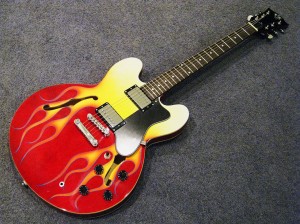
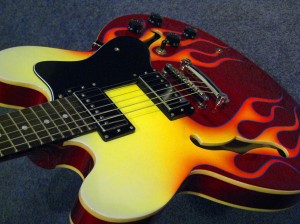
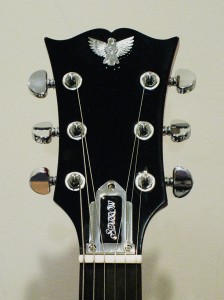
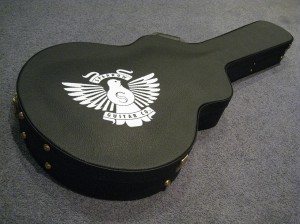
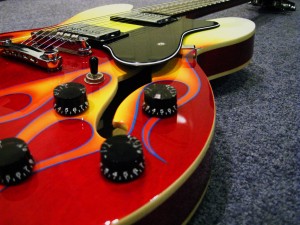
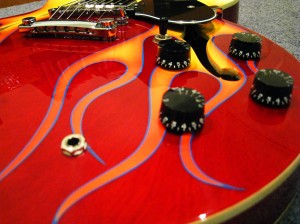
Great article EXCEPT that the headstock logo and truss rod cover are stainless steel NOT plastic. I own several Sparrow’s and am happy with them all. Props to Niche Music Supplies for being the first to pick up on these beauties and bringing them over, will save me the hassle of importing on my next one : )
Hi Michael, thanks for the clarification – we’ve posted an update to the article.
By the way, which models have you got? Any favourites in particular?
[…] covered the launch of Sparrow Guitars in Australia previously, and have even reviewed the Sparrow Primitive Boss – have a read if you haven’t done so already. We are also currently reviewing the Rat Rod […]
I purchased my Big Daddy Ace about five or so years ago, and was impressed right away. My arthritis got worse about the same time, so I just put the guitar in it’s nice case and over the past five years it has sat. I still open the case from time to time to just hold it and look at it. Sometimes I may go through a few chords , but alas, I always have to stop just short of completing a whole song. I just wanted to say how sad I am that they are no longer made. Their song wasn’t finished either. If you have a chance to buy one, don’t hesitate. Just do it! You won’t be sorry.